Chapter 12. Southcoastal Alaska
Day 87 - August 10 - Worthington Glacier and Blueberry Lake
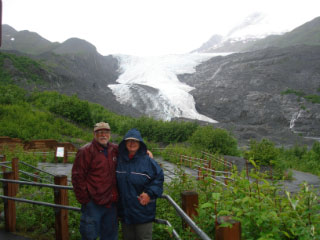 (Bert)
Clouded over and drizzling, we make few stops on our way south from Glennallen,
heading toward Valdez. Now Shari has May programmed to talk to us when we are
near a geocache, so we stop at the entrance to a state recreation site and she
finds the cache near the gate and we stop a second time at Worthington Glacier
where the geocache goal is to take a photograph from a particular GPS location.
I’ve wanted to stop at Worthington Glacier every time we’ve driven this road,
but the weather has always been lousy – as it is again today – so Shari
persuaded me to drive past. This time, with a geocache, she doesn’t care about
the rain, so I get to see the glacier up close.
(Bert)
Clouded over and drizzling, we make few stops on our way south from Glennallen,
heading toward Valdez. Now Shari has May programmed to talk to us when we are
near a geocache, so we stop at the entrance to a state recreation site and she
finds the cache near the gate and we stop a second time at Worthington Glacier
where the geocache goal is to take a photograph from a particular GPS location.
I’ve wanted to stop at Worthington Glacier every time we’ve driven this road,
but the weather has always been lousy – as it is again today – so Shari
persuaded me to drive past. This time, with a geocache, she doesn’t care about
the rain, so I get to see the glacier up close.
We cross Thompson Pass in light rain. I checked my journal for 2006 and see
that I wrote “fog and sleet”, so I guess the weather is better today. The rain
has almost stopped when we reach Blueberry Lake where we will camp tonight. We
meet the camp hosts and Shari invites them to our hotdog roast and the hostess
accepts and even brings over a pile of firewood. The wood needs splitting, so I
spend the next hour making kindling out of thick spruce chunks full of knots, a
tough job. Before our meal Shari and I lead a discussion on berries and
mushrooms, including hints on how to separate the delicious from the poisonous.
Curiously, the namesake berries that grow profusely at Blueberry Lake have not a
single berry this season. The weather has been too cold for the plants to bloom!
Day 88 - August 11 - Thompson Pass
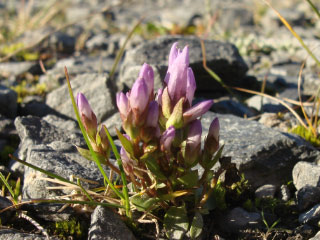 (Bert)
At about 1 AM I look at the nighttime sky – we now have many hours of darkness –
and see bright stars. At daylight the skies are still cloudless and a brilliant
sun shines on the mountains. What a perfect day to investigate Thompson Pass. At
2678 ft., it may not seem all that high compared to mountain passes in the Lower
48, but here in Alaska it is enough to be shut down by snowstorms in winter.
What attracts us today is it is well above tree line and the subalpine terrain
produces a wide variety of wildflowers. This time of year, birds are sparse and
we only see three species – Bald Eagle, Savannah Sparrow, Golden-crowned Sparrow
– plus hear Black-billed Magpie and John adds two more, Wilson’s Warbler and
American Tree Sparrow. That’s undoubtedly the shortest bird list for any
half-day trip we have done. However, more than making up for the short list is
the many wildflowers we find. We start casually, identifying a few as we hike.
With the paucity of birds, the whole group is soon looking down on the rocky
ground in search of more flowers. Our list grows to 42 flower species identified
and three more no one recognizes and we cannot find in a book. Surprisingly, we
find many flowers in bloom that should long have expired. Alaska Violet, Alpine
Forget-me-not, Arctic Lupine, Roseroot normally loose their blossoms in early to
late July, and yet are still in bloom now August 11. We find a big patch of
Common Fireweed, leafy green but without a single flower, a surprise since at
lower elevations the fireweed is near the end of its blooming cycle and here
hasn’t even started. The late bloomers and non-bloomers are further evidence to
the cold months and absence of any real summer.
(Bert)
At about 1 AM I look at the nighttime sky – we now have many hours of darkness –
and see bright stars. At daylight the skies are still cloudless and a brilliant
sun shines on the mountains. What a perfect day to investigate Thompson Pass. At
2678 ft., it may not seem all that high compared to mountain passes in the Lower
48, but here in Alaska it is enough to be shut down by snowstorms in winter.
What attracts us today is it is well above tree line and the subalpine terrain
produces a wide variety of wildflowers. This time of year, birds are sparse and
we only see three species – Bald Eagle, Savannah Sparrow, Golden-crowned Sparrow
– plus hear Black-billed Magpie and John adds two more, Wilson’s Warbler and
American Tree Sparrow. That’s undoubtedly the shortest bird list for any
half-day trip we have done. However, more than making up for the short list is
the many wildflowers we find. We start casually, identifying a few as we hike.
With the paucity of birds, the whole group is soon looking down on the rocky
ground in search of more flowers. Our list grows to 42 flower species identified
and three more no one recognizes and we cannot find in a book. Surprisingly, we
find many flowers in bloom that should long have expired. Alaska Violet, Alpine
Forget-me-not, Arctic Lupine, Roseroot normally loose their blossoms in early to
late July, and yet are still in bloom now August 11. We find a big patch of
Common Fireweed, leafy green but without a single flower, a surprise since at
lower elevations the fireweed is near the end of its blooming cycle and here
hasn’t even started. The late bloomers and non-bloomers are further evidence to
the cold months and absence of any real summer.
Day 89 - August 12 - Valdez and Prince William Sound
(Shari) I suppose you have been wondering “Where is Shari?” She has not
written in quite awhile. Well, I just had nothing to write about and Bert told
you all we did. Yesterday, while the group was out, I got to sleep in and then
walked to a nearby cache. I was alone so I whistled and talked to myself hoping
not to come across a bear. I found the cache but had to climb a rock to get at
it. We had a slam dunk beautiful day and arrived in Valdez in full sun. Too bad
it only lasted yesterday because this morning it is cloudy while we visit the
Valdez Historical Museum. The most fascinating thing here is a movie about the
earthquake and how it affected some individuals. A great animation shows how the
recently docked ferry broke from the pier and then slammed back into it and back
out again. The town was devastated with 22 people killed. Two years later, the
town was relocated to its present site on more stable ground about 4 mi. away.
It is a lovely city but too bad it rains so much.
This afternoon we take a boat trip out into the sound to see wildlife and the
Columbia Glacier. I swear whales like sunshine and stay hidden and sleep during
cloudy and rainy weather. We see only one whale during our 7 hr. trip. Owing to
lack of wildlife, Captain Fred fills in the gaps with constant chatter that to
some becomes tedious. Maybe I am tired of his spiel since it is the fourth time
I have heard it. We arrive back to the harbor starved and twelve of us head out
for a late dinner. Bert never likes Chinese, but he likes this restaurant.
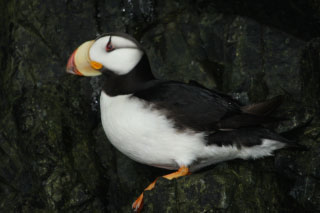 (Bert)
The Earthquake Museum shows a layout of Old Valdez before it was destroyed by
the 1964 earthquake that centered close to town, as well as photos and artifacts
of that time period. The movie we have seen other years has been completely
redone, now a well constructed narration with personal interviews of the events
as they unfolded, the type of film you would expect to see on the History
Channel.
(Bert)
The Earthquake Museum shows a layout of Old Valdez before it was destroyed by
the 1964 earthquake that centered close to town, as well as photos and artifacts
of that time period. The movie we have seen other years has been completely
redone, now a well constructed narration with personal interviews of the events
as they unfolded, the type of film you would expect to see on the History
Channel.
In the afternoon we board the Lu Lu Belle for an excursion of Prince William
Sound. The standout experience is when Captain Fred edges his boat into a very
narrow opening in the rock cliffs, the first opening demonstrating how
perilously close he can wedge between the rocks with his precious teak laid
vessel and its antique Oriental rugs, and the second opening giving us
incredibly close up views of puffins perched on rock ledges. The Horned Puffins
prefer the darker crevices and remain perched while everyone has cameras aimed
at them. They certainly rank high among bird oddities with cartoon like heads
sporting oversized ostentatious yellow bills trimmed in orange, white faces off
centered by orange cat’s-eye-marble eyes, a mascara black trailing eye line and
a curious twisted black feather gaudily pointing upward from the eye. Completing
its adornment is a black and white tuxedo body and duck-like orange legs and
feet. The Tufted Puffins prefer the exposed rock cliff perches. Contrastingly,
they wear all black tuxedos – “tough guys wear black” – have mostly orange bills
and a bad-hair-day tuft of yellowish white feathers ornamentally completing
their headdress. Adjacent to the vertical cliffs, the basal rocks of a boulder
beach support a colony of Steller’s Sea Lions that loudly lounge, bellowing,
belching and barking as they negotiate purchase in the overcrowded shore.
We cruise on through Prince William Sound – named Sandwich first by Captain
James Cook, after his benefactor Earl of Sandwich, but upon his return to
England renamed in honor of the young prince who would be king – through
intermittent rain and drier winds, causing many of us to shuttle between fore
and aft, inside and outside, and up and down the three tiers of the Lu Lu Belle.
Captain Fred seeks a whale, which are exceedingly and atypically scarce today.
Eventually, he spots a spouting Humpback Whale and he edges ever closer to the
rubbery-looking gray object lounging casually in the sea. We wait endlessly for
the whale to dive and the captain keeps his boat positioned at the whale’s tail
end to give us the best view whenever it decides to resume feeding. Now the
whale just floats at the surface, apparently asleep, periodically exhausting its
lungs through the blowhole and refilling, an act it can do without waking. We
drift so close to the whale that I can see scratch marks on its slippery dark
back and I can make out the contours of its blowhole, a raised dimple with a
concave hole. We must have been in the whale’s presence for 45 min. before it
awakes. All this time I’ve had my camera at the ready, shielding the long lens
from the light drizzle with my handkerchief. Now the action starts and I rapidly
snap a series of photos: the blowhole poking just above the water’s surface,
then dipping as the body arches, the dorsal fin exposed, raising slowly to the
top of the arch, then dropping forward in the continued arching of its back, the
tail breaks the surface exposing its wide horizontal fins, the whole fluke above
the sea and dripping a waterfall over its edges, now straight up as a triangular
fluke supported by the last part of the exposed body, and finally it too
dropping below the surface and leaving only an oily ripple. It’s the only whale
we see today, but certainly ranks as my longest experience in the presence of a
single whale and my closest observation of its nautical performance.
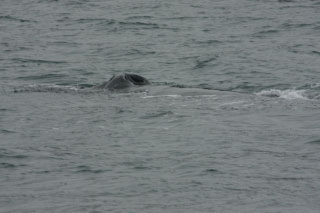
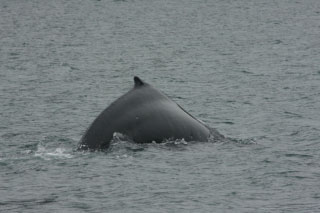
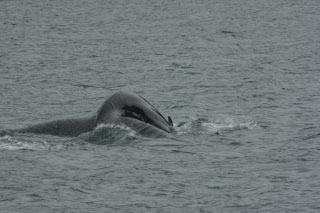
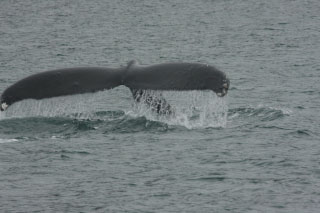
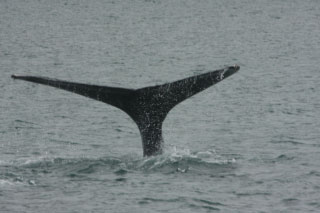
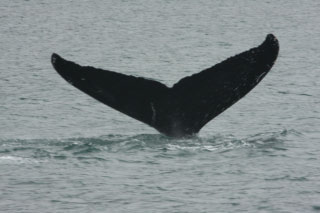
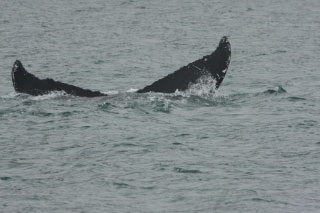
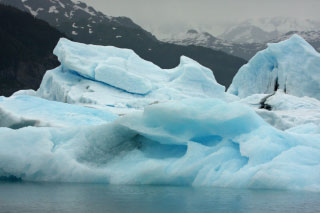 The
Lu Lu Belle turns towards Columbia Glacier, one of the most famous of Alaska’s
myriad glaciers. Some years ago now the calving glacier has dumped icebergs into
the bay that have become hung up on an old, now submerged, terminal moraine that
reaches to about 35 ft. from the surface, too shallow for the icebergs to float
out to sea. With water temperatures at or below freezing near the glacier front,
the icebergs don’t melt, but instead break up into smaller chunks that
eventually escape. Pertinent to us is that we can’t get within 7 mi. of the
glacier – where the water depth is over 1000 ft. - and instead are encumbered
and surrounded by the marvelously blue ice, many of which extend high above the
boat. A geologist on board as a passenger has a keen interest in the rocks
transported by glaciers and one of the young ladies who serves as deckhand
obliges by climbing off the boat’s bow and alighting on a floating iceberg,
retrieves an armful of rocks for the geologist and accepts a helping hand to
jump back into the boat. That iceberg would not have been a good place to be
marooned!
The
Lu Lu Belle turns towards Columbia Glacier, one of the most famous of Alaska’s
myriad glaciers. Some years ago now the calving glacier has dumped icebergs into
the bay that have become hung up on an old, now submerged, terminal moraine that
reaches to about 35 ft. from the surface, too shallow for the icebergs to float
out to sea. With water temperatures at or below freezing near the glacier front,
the icebergs don’t melt, but instead break up into smaller chunks that
eventually escape. Pertinent to us is that we can’t get within 7 mi. of the
glacier – where the water depth is over 1000 ft. - and instead are encumbered
and surrounded by the marvelously blue ice, many of which extend high above the
boat. A geologist on board as a passenger has a keen interest in the rocks
transported by glaciers and one of the young ladies who serves as deckhand
obliges by climbing off the boat’s bow and alighting on a floating iceberg,
retrieves an armful of rocks for the geologist and accepts a helping hand to
jump back into the boat. That iceberg would not have been a good place to be
marooned!
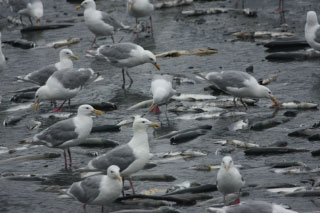 Day
90 - August 13 - Valdez
Day
90 - August 13 - Valdez
(Bert) Rain continues this morning, but not willing to let that stop us,
almost everyone seems to head out in a different direction on this free day.
John joins Shari and me as we drive around the bay to the fish ladder near the
pipeline oil storage tanks. Permeating the shoreline and creeks are thousands of
dead and dying Pink Salmon. Thousands struggle against the strong current,
shifting to the edges where the water force is weaker, lined up parallelly in
densities thick enough that it makes you think you could walk across their
exposed backs. Now at low tide, the water is not deep enough for them to make
much forward progress. Thousands more litter the gravel with dead carcasses,
grotesquely emaciated with hooked bills, arched backs and bodies nipped by a
feeding frenzy of Glaucous-winged Gulls. Some died trapped in tangled discarded
chain link fence, some suffocated on gravel exposed during low tide, some still
breathe weakly but cannot see from eyes gorged out by gulls as their primary
delicacy. The whole scene is rather depressing and fit for an apocalyptic movie
on the end of the world. Looking for a bright side to the story, John and I find
the fish ladder, a ever rising series of water filled concrete steps with open
gaps through which the strongest of salmon climb from sea level to the hatchery
50 ft. higher. The hardy swimmers struggle for hours but eventually reach the
serene pools above, where they will be milked of their eggs and sperm. Females
carry 1500-2000 eggs, are placed in incubators and the subsequent fry are fed
through the winter to be released the following spring. This hatchery releases
230 million pinks and 2 million silvers, as well as Chum and King salmon.
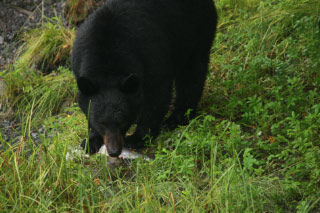 (Shari)
A fish, a bear, a geocache and a berry - that about sums up the day! It does not
get much better than that for me. I woke at 6 this morning to the tune of rain
hitting our roof. Darn, I wish I had not half promised Bent and Marie that I
would be going fishing. I stumble around R-Tent-III and am out by 7. John S is
the only other person accompanying us on our outing. Bent and Marie do not even
show up! I could have slept in. The rain gets harder and the fog starts to roll
in. We stop at the fish hatching area, looking for the reported bears. The tide
is out and millions and zillions of fish are thrashing in shallow water or dead
on the exposed beach. We continue down to the oil pipeline barricade and park at
the campground. I see some people fishing on the shore and decide to try my
luck. You can see the fins of the fish for heaven’s sake. I surely should be
able to catch one. A young couple climbs up the path with a bag full of 11 fish.
Wow! I grab my tackle box, my rod and my net and head to the water. My line is
twisted. John helps by cutting off the lure and rethreading the line. I cast
out, noticing that John gives me a wide berth. I reel in. Nothing yet. I repeat
the process. I move down the beach. I move back up the beach. All of a sudden I
get a strike and I yell, “Get the net”. I beach a nice big Pink or Humpy, as
they are called. I try a few more casts but the rain is coming down harder and I
know Bert and John do not want to spend all morning watching me fish. So I pack
up my stuff. I am happy with one. I don’t especially like to eat Pinks anyway.
We start the drive back and see a Black Bear on the side of the road gorging
himself with salmon. After getting our fill of him we head to camp. After lunch,
Bert and I go to the Whitney Museum, a fascinating place of items from one
woman’s collection. She spent much of her life gathering things unique to Alaska
and then sold them in her shop in Fairbanks. We try to find a cache but May
keeps shutting herself off. We go home and Bert takes out her battery and puts
it back in and she works fine. Go figure! There is still enough time to walk to
an overlook for a geocache. On our way we stop to visit with a falconer who is
training a Goshawk in the nearby park. I find the cache, Bert picks a pint of
salmonberries and we make it back just in time for our social and travel
meeting. I loose control of the group when they decide they’d rather eat Marie’s
and Betty’s yummy snacks than listen to a travel meeting. Later Marie and I
notice the cruise ship has left and the town pier is available for fishing.
Hearing that Silvers are being caught, we along with Bent gather our stuff to
try our luck. During the next hour I only see one fish caught so I give up. I
have so much to do and am tired. Leaving Bent and Marie with herring on their
hook still attempting to catch fish, I drive home. A fish, a bear, a cache and a
berry – what more could I want!
(Shari)
A fish, a bear, a geocache and a berry - that about sums up the day! It does not
get much better than that for me. I woke at 6 this morning to the tune of rain
hitting our roof. Darn, I wish I had not half promised Bent and Marie that I
would be going fishing. I stumble around R-Tent-III and am out by 7. John S is
the only other person accompanying us on our outing. Bent and Marie do not even
show up! I could have slept in. The rain gets harder and the fog starts to roll
in. We stop at the fish hatching area, looking for the reported bears. The tide
is out and millions and zillions of fish are thrashing in shallow water or dead
on the exposed beach. We continue down to the oil pipeline barricade and park at
the campground. I see some people fishing on the shore and decide to try my
luck. You can see the fins of the fish for heaven’s sake. I surely should be
able to catch one. A young couple climbs up the path with a bag full of 11 fish.
Wow! I grab my tackle box, my rod and my net and head to the water. My line is
twisted. John helps by cutting off the lure and rethreading the line. I cast
out, noticing that John gives me a wide berth. I reel in. Nothing yet. I repeat
the process. I move down the beach. I move back up the beach. All of a sudden I
get a strike and I yell, “Get the net”. I beach a nice big Pink or Humpy, as
they are called. I try a few more casts but the rain is coming down harder and I
know Bert and John do not want to spend all morning watching me fish. So I pack
up my stuff. I am happy with one. I don’t especially like to eat Pinks anyway.
We start the drive back and see a Black Bear on the side of the road gorging
himself with salmon. After getting our fill of him we head to camp. After lunch,
Bert and I go to the Whitney Museum, a fascinating place of items from one
woman’s collection. She spent much of her life gathering things unique to Alaska
and then sold them in her shop in Fairbanks. We try to find a cache but May
keeps shutting herself off. We go home and Bert takes out her battery and puts
it back in and she works fine. Go figure! There is still enough time to walk to
an overlook for a geocache. On our way we stop to visit with a falconer who is
training a Goshawk in the nearby park. I find the cache, Bert picks a pint of
salmonberries and we make it back just in time for our social and travel
meeting. I loose control of the group when they decide they’d rather eat Marie’s
and Betty’s yummy snacks than listen to a travel meeting. Later Marie and I
notice the cruise ship has left and the town pier is available for fishing.
Hearing that Silvers are being caught, we along with Bent gather our stuff to
try our luck. During the next hour I only see one fish caught so I give up. I
have so much to do and am tired. Leaving Bent and Marie with herring on their
hook still attempting to catch fish, I drive home. A fish, a bear, a cache and a
berry – what more could I want!
 Next
Day
Next
Day  Table
of Contents
Table
of Contents
 (Bert)
Clouded over and drizzling, we make few stops on our way south from Glennallen,
heading toward Valdez. Now Shari has May programmed to talk to us when we are
near a geocache, so we stop at the entrance to a state recreation site and she
finds the cache near the gate and we stop a second time at Worthington Glacier
where the geocache goal is to take a photograph from a particular GPS location.
I’ve wanted to stop at Worthington Glacier every time we’ve driven this road,
but the weather has always been lousy – as it is again today – so Shari
persuaded me to drive past. This time, with a geocache, she doesn’t care about
the rain, so I get to see the glacier up close.
(Bert)
Clouded over and drizzling, we make few stops on our way south from Glennallen,
heading toward Valdez. Now Shari has May programmed to talk to us when we are
near a geocache, so we stop at the entrance to a state recreation site and she
finds the cache near the gate and we stop a second time at Worthington Glacier
where the geocache goal is to take a photograph from a particular GPS location.
I’ve wanted to stop at Worthington Glacier every time we’ve driven this road,
but the weather has always been lousy – as it is again today – so Shari
persuaded me to drive past. This time, with a geocache, she doesn’t care about
the rain, so I get to see the glacier up close.  (Bert)
At about 1 AM I look at the nighttime sky – we now have many hours of darkness –
and see bright stars. At daylight the skies are still cloudless and a brilliant
sun shines on the mountains. What a perfect day to investigate Thompson Pass. At
2678 ft., it may not seem all that high compared to mountain passes in the Lower
48, but here in Alaska it is enough to be shut down by snowstorms in winter.
What attracts us today is it is well above tree line and the subalpine terrain
produces a wide variety of wildflowers. This time of year, birds are sparse and
we only see three species – Bald Eagle, Savannah Sparrow, Golden-crowned Sparrow
– plus hear Black-billed Magpie and John adds two more, Wilson’s Warbler and
American Tree Sparrow. That’s undoubtedly the shortest bird list for any
half-day trip we have done. However, more than making up for the short list is
the many wildflowers we find. We start casually, identifying a few as we hike.
With the paucity of birds, the whole group is soon looking down on the rocky
ground in search of more flowers. Our list grows to 42 flower species identified
and three more no one recognizes and we cannot find in a book. Surprisingly, we
find many flowers in bloom that should long have expired. Alaska Violet, Alpine
Forget-me-not, Arctic Lupine, Roseroot normally loose their blossoms in early to
late July, and yet are still in bloom now August 11. We find a big patch of
Common Fireweed, leafy green but without a single flower, a surprise since at
lower elevations the fireweed is near the end of its blooming cycle and here
hasn’t even started. The late bloomers and non-bloomers are further evidence to
the cold months and absence of any real summer.
(Bert)
At about 1 AM I look at the nighttime sky – we now have many hours of darkness –
and see bright stars. At daylight the skies are still cloudless and a brilliant
sun shines on the mountains. What a perfect day to investigate Thompson Pass. At
2678 ft., it may not seem all that high compared to mountain passes in the Lower
48, but here in Alaska it is enough to be shut down by snowstorms in winter.
What attracts us today is it is well above tree line and the subalpine terrain
produces a wide variety of wildflowers. This time of year, birds are sparse and
we only see three species – Bald Eagle, Savannah Sparrow, Golden-crowned Sparrow
– plus hear Black-billed Magpie and John adds two more, Wilson’s Warbler and
American Tree Sparrow. That’s undoubtedly the shortest bird list for any
half-day trip we have done. However, more than making up for the short list is
the many wildflowers we find. We start casually, identifying a few as we hike.
With the paucity of birds, the whole group is soon looking down on the rocky
ground in search of more flowers. Our list grows to 42 flower species identified
and three more no one recognizes and we cannot find in a book. Surprisingly, we
find many flowers in bloom that should long have expired. Alaska Violet, Alpine
Forget-me-not, Arctic Lupine, Roseroot normally loose their blossoms in early to
late July, and yet are still in bloom now August 11. We find a big patch of
Common Fireweed, leafy green but without a single flower, a surprise since at
lower elevations the fireweed is near the end of its blooming cycle and here
hasn’t even started. The late bloomers and non-bloomers are further evidence to
the cold months and absence of any real summer.  (Bert)
The Earthquake Museum shows a layout of Old Valdez before it was destroyed by
the 1964 earthquake that centered close to town, as well as photos and artifacts
of that time period. The movie we have seen other years has been completely
redone, now a well constructed narration with personal interviews of the events
as they unfolded, the type of film you would expect to see on the History
Channel.
(Bert)
The Earthquake Museum shows a layout of Old Valdez before it was destroyed by
the 1964 earthquake that centered close to town, as well as photos and artifacts
of that time period. The movie we have seen other years has been completely
redone, now a well constructed narration with personal interviews of the events
as they unfolded, the type of film you would expect to see on the History
Channel. 






 The
Lu Lu Belle turns towards Columbia Glacier, one of the most famous of Alaska’s
myriad glaciers. Some years ago now the calving glacier has dumped icebergs into
the bay that have become hung up on an old, now submerged, terminal moraine that
reaches to about 35 ft. from the surface, too shallow for the icebergs to float
out to sea. With water temperatures at or below freezing near the glacier front,
the icebergs don’t melt, but instead break up into smaller chunks that
eventually escape. Pertinent to us is that we can’t get within 7 mi. of the
glacier – where the water depth is over 1000 ft. - and instead are encumbered
and surrounded by the marvelously blue ice, many of which extend high above the
boat. A geologist on board as a passenger has a keen interest in the rocks
transported by glaciers and one of the young ladies who serves as deckhand
obliges by climbing off the boat’s bow and alighting on a floating iceberg,
retrieves an armful of rocks for the geologist and accepts a helping hand to
jump back into the boat. That iceberg would not have been a good place to be
marooned!
The
Lu Lu Belle turns towards Columbia Glacier, one of the most famous of Alaska’s
myriad glaciers. Some years ago now the calving glacier has dumped icebergs into
the bay that have become hung up on an old, now submerged, terminal moraine that
reaches to about 35 ft. from the surface, too shallow for the icebergs to float
out to sea. With water temperatures at or below freezing near the glacier front,
the icebergs don’t melt, but instead break up into smaller chunks that
eventually escape. Pertinent to us is that we can’t get within 7 mi. of the
glacier – where the water depth is over 1000 ft. - and instead are encumbered
and surrounded by the marvelously blue ice, many of which extend high above the
boat. A geologist on board as a passenger has a keen interest in the rocks
transported by glaciers and one of the young ladies who serves as deckhand
obliges by climbing off the boat’s bow and alighting on a floating iceberg,
retrieves an armful of rocks for the geologist and accepts a helping hand to
jump back into the boat. That iceberg would not have been a good place to be
marooned!  Day
90 - August 13 - Valdez
Day
90 - August 13 - Valdez  (Shari)
A fish, a bear, a geocache and a berry - that about sums up the day! It does not
get much better than that for me. I woke at 6 this morning to the tune of rain
hitting our roof. Darn, I wish I had not half promised Bent and Marie that I
would be going fishing. I stumble around R-Tent-III and am out by 7. John S is
the only other person accompanying us on our outing. Bent and Marie do not even
show up! I could have slept in. The rain gets harder and the fog starts to roll
in. We stop at the fish hatching area, looking for the reported bears. The tide
is out and millions and zillions of fish are thrashing in shallow water or dead
on the exposed beach. We continue down to the oil pipeline barricade and park at
the campground. I see some people fishing on the shore and decide to try my
luck. You can see the fins of the fish for heaven’s sake. I surely should be
able to catch one. A young couple climbs up the path with a bag full of 11 fish.
Wow! I grab my tackle box, my rod and my net and head to the water. My line is
twisted. John helps by cutting off the lure and rethreading the line. I cast
out, noticing that John gives me a wide berth. I reel in. Nothing yet. I repeat
the process. I move down the beach. I move back up the beach. All of a sudden I
get a strike and I yell, “Get the net”. I beach a nice big Pink or Humpy, as
they are called. I try a few more casts but the rain is coming down harder and I
know Bert and John do not want to spend all morning watching me fish. So I pack
up my stuff. I am happy with one. I don’t especially like to eat Pinks anyway.
We start the drive back and see a Black Bear on the side of the road gorging
himself with salmon. After getting our fill of him we head to camp. After lunch,
Bert and I go to the Whitney Museum, a fascinating place of items from one
woman’s collection. She spent much of her life gathering things unique to Alaska
and then sold them in her shop in Fairbanks. We try to find a cache but May
keeps shutting herself off. We go home and Bert takes out her battery and puts
it back in and she works fine. Go figure! There is still enough time to walk to
an overlook for a geocache. On our way we stop to visit with a falconer who is
training a Goshawk in the nearby park. I find the cache, Bert picks a pint of
salmonberries and we make it back just in time for our social and travel
meeting. I loose control of the group when they decide they’d rather eat Marie’s
and Betty’s yummy snacks than listen to a travel meeting. Later Marie and I
notice the cruise ship has left and the town pier is available for fishing.
Hearing that Silvers are being caught, we along with Bent gather our stuff to
try our luck. During the next hour I only see one fish caught so I give up. I
have so much to do and am tired. Leaving Bent and Marie with herring on their
hook still attempting to catch fish, I drive home. A fish, a bear, a cache and a
berry – what more could I want!
(Shari)
A fish, a bear, a geocache and a berry - that about sums up the day! It does not
get much better than that for me. I woke at 6 this morning to the tune of rain
hitting our roof. Darn, I wish I had not half promised Bent and Marie that I
would be going fishing. I stumble around R-Tent-III and am out by 7. John S is
the only other person accompanying us on our outing. Bent and Marie do not even
show up! I could have slept in. The rain gets harder and the fog starts to roll
in. We stop at the fish hatching area, looking for the reported bears. The tide
is out and millions and zillions of fish are thrashing in shallow water or dead
on the exposed beach. We continue down to the oil pipeline barricade and park at
the campground. I see some people fishing on the shore and decide to try my
luck. You can see the fins of the fish for heaven’s sake. I surely should be
able to catch one. A young couple climbs up the path with a bag full of 11 fish.
Wow! I grab my tackle box, my rod and my net and head to the water. My line is
twisted. John helps by cutting off the lure and rethreading the line. I cast
out, noticing that John gives me a wide berth. I reel in. Nothing yet. I repeat
the process. I move down the beach. I move back up the beach. All of a sudden I
get a strike and I yell, “Get the net”. I beach a nice big Pink or Humpy, as
they are called. I try a few more casts but the rain is coming down harder and I
know Bert and John do not want to spend all morning watching me fish. So I pack
up my stuff. I am happy with one. I don’t especially like to eat Pinks anyway.
We start the drive back and see a Black Bear on the side of the road gorging
himself with salmon. After getting our fill of him we head to camp. After lunch,
Bert and I go to the Whitney Museum, a fascinating place of items from one
woman’s collection. She spent much of her life gathering things unique to Alaska
and then sold them in her shop in Fairbanks. We try to find a cache but May
keeps shutting herself off. We go home and Bert takes out her battery and puts
it back in and she works fine. Go figure! There is still enough time to walk to
an overlook for a geocache. On our way we stop to visit with a falconer who is
training a Goshawk in the nearby park. I find the cache, Bert picks a pint of
salmonberries and we make it back just in time for our social and travel
meeting. I loose control of the group when they decide they’d rather eat Marie’s
and Betty’s yummy snacks than listen to a travel meeting. Later Marie and I
notice the cruise ship has left and the town pier is available for fishing.
Hearing that Silvers are being caught, we along with Bent gather our stuff to
try our luck. During the next hour I only see one fish caught so I give up. I
have so much to do and am tired. Leaving Bent and Marie with herring on their
hook still attempting to catch fish, I drive home. A fish, a bear, a cache and a
berry – what more could I want!